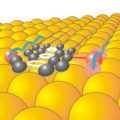
A huge meteor, between 12 and 30 miles in diameter, smashed into the Earth 3.5 billion years ago with the energy of 1 billion atomic bombs, vaporizing the surface where it struck and creating a tsunami more than half a mile high that raced around the world at 500 miles per hour.
This cataclysm is the earliest known meteor strike to hit the Earth, and one of at least four that have been identified in a geologically brief 300-million-year period. The strike is the subject of an article published in the current issue of the journal Science by LSU geologist Gary Byerly and others.
Byerly and Xiaogang Xie, also of LSU, and Donald Lowe and Joseph Wooden of Stanford, identified traces of the event in some of the oldest known rocks on Earth — in South Africa and Northwest Australia.
When the asteroid hit, it was vaporized by the extreme energy of the impact. Condensation of this vapor produced droplets of melt, called spherules, which dropped into the roiling sea over the next few days and were deposited in layers on the sea floor.
Byerly said it was not known where the meteor hit, but it was probably some distance from where they found the spherules and probably in water rather than on land. He deduced this because the composition of the spherules lacked the mineral composition that would have been expected from vaporization of the continental crust, and because there was even more water covering the surface of the Earth then than there is today.
The water would likely have inundated everything but the mountains, Byerly said, and drastically eroded the continental land masses, changing their coastlines dramatically. The heat of the impact would have evaporated the upper 30 to 300 feet of water in the oceans. It would also have killed everything, or almost everything, that was alive at that time on land or near the ocean surface.
“There was almost certainly life at this time. Primitive, bacterial life, and if the impacts were made by a meteor 20 miles in diameter, they would have killed everything on the surface of the Earth,” he said. First a hot steam of molten rock and water would have withered most life, then the massively destructive tsunamis would have destroyed even more. After that, years of incredibly cold winters, caused by particles in the atmosphere blocking out the sun, would have conspired to kill nearly everything else.
“Anything that survived would have been in deep rocks or below the surface of the Earth,” he said.
Byerly first came upon evidence of these impacts by chance in 1984 while he was studying ancient volcanism in Australia and South Africa. He published his first paper on them in 1986. This year alone he and his team will have four papers published on the subject. It is now generally accepted that the inner solar system was battered twice by massive meteor impacts of mysterious origin.
“It is assumed that the solar system was created by a cloud of dust and rocks that condensed into the sun and planets, with larger and larger chunks falling in near the end. This process would have finished about 4.5 billion years ago.
“But about 3.8 billion years ago the inner solar system was torn up by some cataclysmic event. The evidence is found in the crater basins on the moon and Mars and Venus.” The Earth was probably heavily battered at that time too, but since the oldest known surface rocks on Earth are about 3.5 billion years old, no evidence of that exists, Byerly said.
A second battering took place 3.5 billion years ago, and it is this event that left the record in the rocks Byerly is studying. This was a smaller series of impacts with a gradual dropoff rate, he said. That the 3.8 billion-year-old event occurred is accepted by most scientists, and Byerly’s work is substantiating the existence of the second, which, up to now, has not been as well accepted.
Byerly and his team have been able to date the event very accurately using an instrument at Stanford that measures the decay of uranium into lead. The uranium was found in zircons at both the Australian and South African sites and was dated to within 2 million years of 3.47 billion years ago. The fact that zircons of identical ages were found in impact strata on two continents shows the worldwide effects of the impact, Byerly said.
The zircons were not created by the impact but probably by volcanic action and deposited in the impact layers when the tsunami washed over the land.
These massive, early impacts were similar to the one that killed the dinosaurs 65 million years ago. But, they were hundreds to thousands of times more powerful. Probabilities for a similar impact today are predicted to be about one such strike every 100 million years.
“What that means is, eventually there will be another such event. We know that large asteroids get disturbed by interactions with Jupiter and fall into Earth’s orbit. When that happens they will strike the Earth. We can’t say when it will happen but we can say for certain that it will happen,” Byerly said.


















Comments are closed.